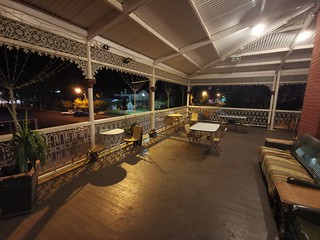Tomorrow I will appreciate the many transitions in the landscape during my 13 hour trip back to Sydney on the Outback Explorer train, after being away for ten days.
My first stop was Melbourne, before taking the 130 year old Overland train journey to Adelaide, where I stayed for six nights before boarding the NSW railway bus to Broken Hill through the mostly arid countryside of South Australia's mid-north.
I had a few important reasons to visit Adelaide. I wished to spend a day with a cousin whose existence I discovered only about 15 years ago. I also wanted to catch up with a work colleague from 30 years ago. But what was most pressing was the landmark Clarice Beckett exhibition at the Art Gallery of South Australia, as it was due to close yesterday.
Beckett, who lived from 1887 to 1935, is one of Australia's most important modernist painters. Like most Australians I'd never heard of her. But my attention was drawn to her work when I read a review of the show by the Sydney Morning Herald's famously grumpy art critic John McDonald.
He said: 'It’s not often I feel the urge to visit the same show on three successive days, but Clarice Beckett: The Present Moment at the Art Gallery of South Australia, is one of those rare, inexhaustible exhibitions.'
I saw it twice, and I've joined the waiting list for the catalogue, which is being reprinted after selling out. It turns out that they've postponed its closing by a week and extended the daily opening times.
Viewing her paintings, what resonated with me in particular was the setting of the majority of them not far from her longtime residence in the beachside Melbourne suburb of Beaumaris. I grew up in country Victoria but my family went to the neighbouring beach suburb of Black Rock several times, for seaside summer holidays.
I was also interested in the spirituality that underlies the paintings. The exhibition notes describe Beckett as a 'visionary mystic' who was 'receptive to international trends in science, literature, philosophy and spiritualism'.
Beckett would often rise at 4:00 am and walk up to five kilometres from her home to capture the effect of the early morning sea mists. The creator of the musical soundtrack to the exhibition writes of solitude as the central inspiration for her track choices, as she sought to contribute to the creation of 'an intimate space for viewers to contemplate The Present Moment.'
Beckett never travelled beyond Victoria, though she did some of her most renowned paintings during the six months she spent at Naringal Station in the state's Western District. As I sat in the bus travelling through arid regions of South Australia's mid-north yesterday, I wondered what she would have made of them.



